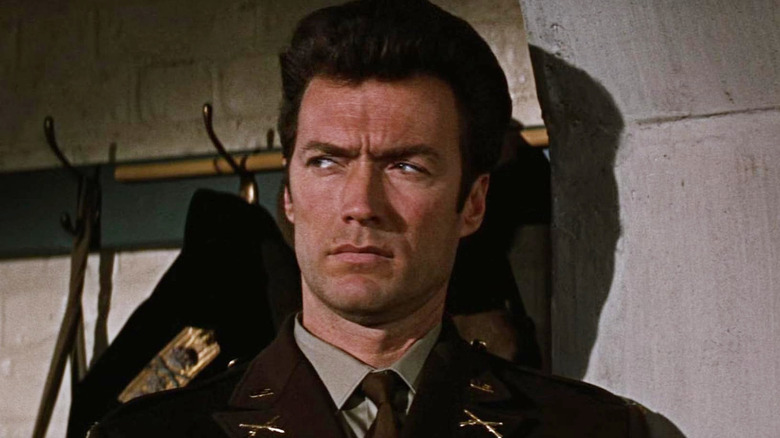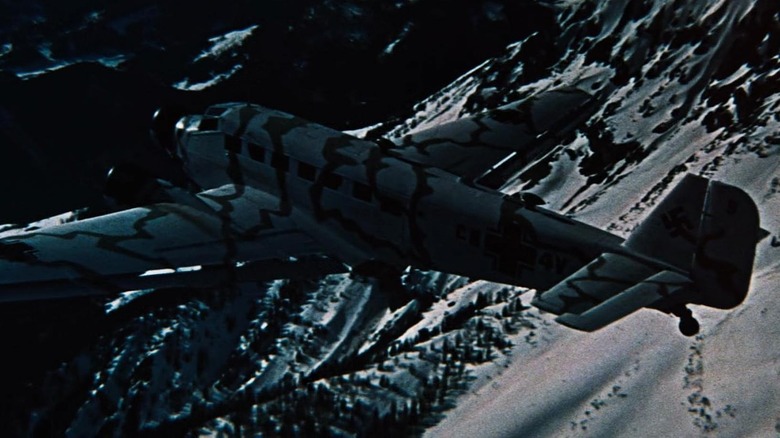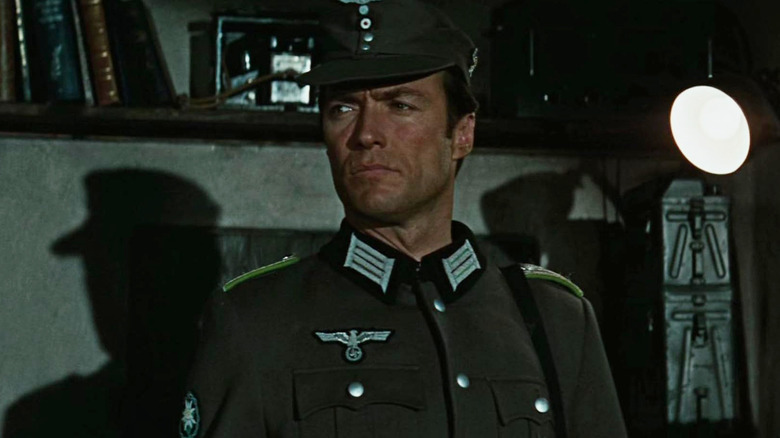Clint Eastwood Gave All His Lines Away In A Major War Movie
We watched a lot of war films in our household when I was a kid. My granddad served in the Royal Air Force in Africa during World War II, and my dad loved action movies, so we tended towards classics like "Ice Cold in Alex" and brawny men-on-a-mission adventures such as "The Great Escape," "Von Ryan's Express," and "The Dirty Dozen." Low on grit and high on derring-do, these flicks were rousing stuff that celebrated stiff upper lips and cool heads under fire, stirring up pride in our nation's part in victory over the Third Reich. My favorite was "Where Eagles Dare;" I was left absolutely breathless when I first saw it and it gave me all the things I wanted from a war movie back then: suspense, double-crosses, explosions, and plenty of Nazis getting what's coming to them. Plus it had cinema's greatest cable car scene and Clint Eastwood playing another monosyllabic badass to stand alongside The Man With No Name and "Dirty" Harry Callahan.
"Where Eagles Dare" was originally devised as a star vehicle for Richard Burton, who was one of cinema's biggest stars in the mid-1960s. Combining critical acclaim for his powerhouse performances in films like "Becket" and "Who's Afraid of Virginia Woolf?" with major box office clout, the British actor also dominated headlines thanks to his tumultuous high-profile relationship with Elizabeth Taylor. He eventually decided to take a break from more serious material and do a fun movie his kids could watch and one that he wouldn't die in — indeed, one of his specifications was that he could waste a few bad guys instead.
Hence, Burton got in touch with producer Elliot Kastner, who in turn enlisted Alistair MacLean, the Scottish author whose action-packed novels provided the source material for war thrillers like "The Guns of Navarone" and "Ice Station Zebra." MacLean then knocked out an original story about a daring rescue mission from an impregnable fortress in the Bavarian Alps, and Burton had his action movie, plus a $1.2 million check and a share of the profits. He was joined by a largely British cast including Mary Ure, Patrick Wymark, Donald Houston, and the ever-wonderful Michael Hordern. To add a little international glamor, these familiar faces were joined by future Hammer horror icon Ingrid Pitt and Eastwood, Hollywood's then-newest tough guy. But, unusually for an up-and-coming star, Eastwood wanted less lines, not more.
What happens in Where Eagles Dare?
You know you're in for a good old-fashioned adventure from the outset with "Where Eagles Dare," as Ron Goodwin's dramatic score accompanies a camouflaged plane flying in low across the snow-capped peaks of the Bavarian Alps. Inside are a crack team of British commandos headed by Major John Smith (Richard Burton) and accompanied by U.S. Army Ranger Lieutenant Morris Schaffer (Clint Eastwood). Also secretly along for the ride is Mary Ellison (Mary Ure), Smith's lover and undercover agent. Their impossible mission is to infiltrate the Schloß Adler fortress on its mountaintop perch and rescue Brigadier General George Carnaby (Robert Beatty), a man whose knowledge is crucial to establishing a second front against the Third Reich to turn the tide of World War II.
However, once the team has parachuted into a snowy alpine pasture, it becomes clear something fishy is going on. One of the commandos is murdered on landing and Smith has objectives unknown to his men, not least the involvement of Ellison. After checking out the fortress and determining that it is only accessible via a cable car, Smith and his team make contact with Heidi Schmidt (Ingrid Pitt), an underground agent who will help Ellison gain access to the "Castle of Eagles" ahead of the team's assault. Things go belly up when another commando is murdered and the rest of the men are captured, leaving just Smith and Schaffer to complete the mission despite orders to abort from H.Q. Can they discover the traitor in their midst and get out of the castle alive?
"Where Eagles Dare" is a slow-burning war thriller by modern standards, at least for the first hour or so. The first shot isn't fired until around the 50 minute mark, as MacLean's screenplay focuses on the team's infiltration of the castle and trying to root out the mole. That said, it certainly rewards the viewer's patience when the action finally kicks in, delivering some famously nail-biting cable car fights and surprisingly cold-blooded violence for the time. By the end, it's like everybody involved is vicariously avenging the horrors of World War II, as our heroes set about blowing up everything and killing everybody in a German uniform as they make their escape. The effects may be old-school, but the carnage is something akin to an '80s Schwarzenegger movie, with Eastwood letting his submachine gun do all the talking.
Why Clint Eastwood gave away his lines in Where Eagles Dare
In a 2009 interview about 'Where Eagles Dare," British actor Darren Nesbitt (who plays SS man Major Von Hapen in the film) revealed that Clint Eastwood gave most of his lines away to Richard Burton. Reportedly, Eastwood had some serious reservations about Alistair MacLean's "terrible" screenplay, feeling that it was too confusing and full of exposition. He wasn't wrong; no matter how many times I see the movie, I still can't get my head around Major Smith's series of bluffs, double-bluffs, and maybe even triple-bluffs that come along in a lengthy sit-down scene reminiscent of Hercule Poirot unveiling the murderer in a whodunnit. Perhaps wisely, Eastwood asked for less dialogue and director Brian Hutton agreed, handing many of his lines to Burton instead.
It wasn't the first time Eastwood had cut down his own speaking time in a movie, however. Once he was hired by Sergio Leone for his star-making turn in "A Fistful of Dollars," Eastwood set about reducing the amount of lines in the script to make his dialogue less expository. The result was that the Man With No Name became more laconic and mysterious, and it was a choice that helped the wandering gunslinger become such an iconic character.
After the international success of Leone's "Dollars Trilogy," the actor nailed down his distinctive screen persona in three 1968 movies: "Hang 'Em High," "Coogan's Bluff," and "Where Eagles Dare." His characters in all three are definitely not the chatty types, providing a through-line from the Spaghetti Westerns with Leone and his shoot-first-ask-questions-later maverick cop in Don Siegel's controversial "Dirty Harry." Certainly, less dialogue for Eastwood works well in "Where Eagles Dare," as Burton's eloquence and mesmerizing voice could make just about anything fly while his American co-star concentrated on the more intense action beats. Together, Burton and Eastwood make for an awkward but strangely effective double act: the former stout, fleshy, and droll; the latter tall, lean, and no-nonsense as he devotes himself to the violence that made his name.
According to All Outta Bubblegum, "Where Eagles Dare" is Eastwood's bloodiest movie ever, chalking up a kill count of 99 bad guys. It's not surprising, either; much of the last act is just Eastwood machine-gunning scores of Nazi soldiers with his trademark squint and grimace.


